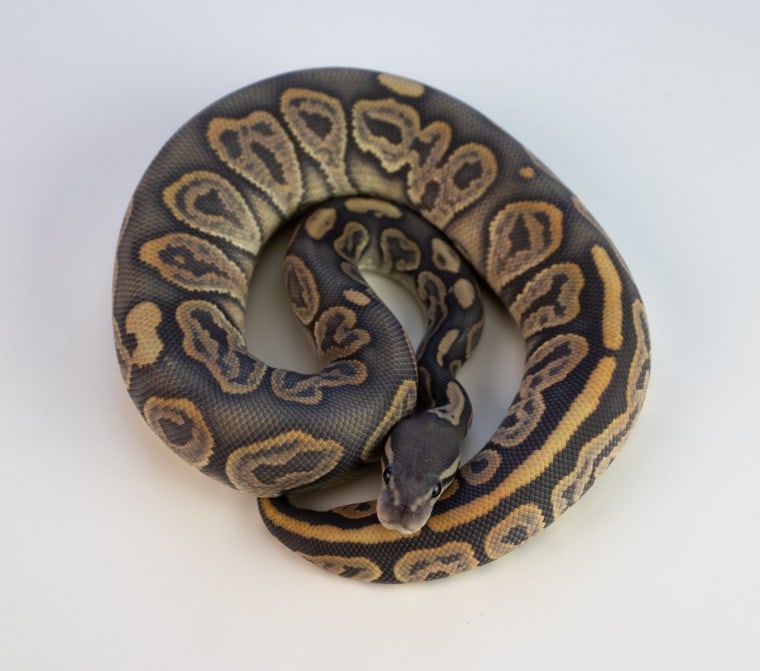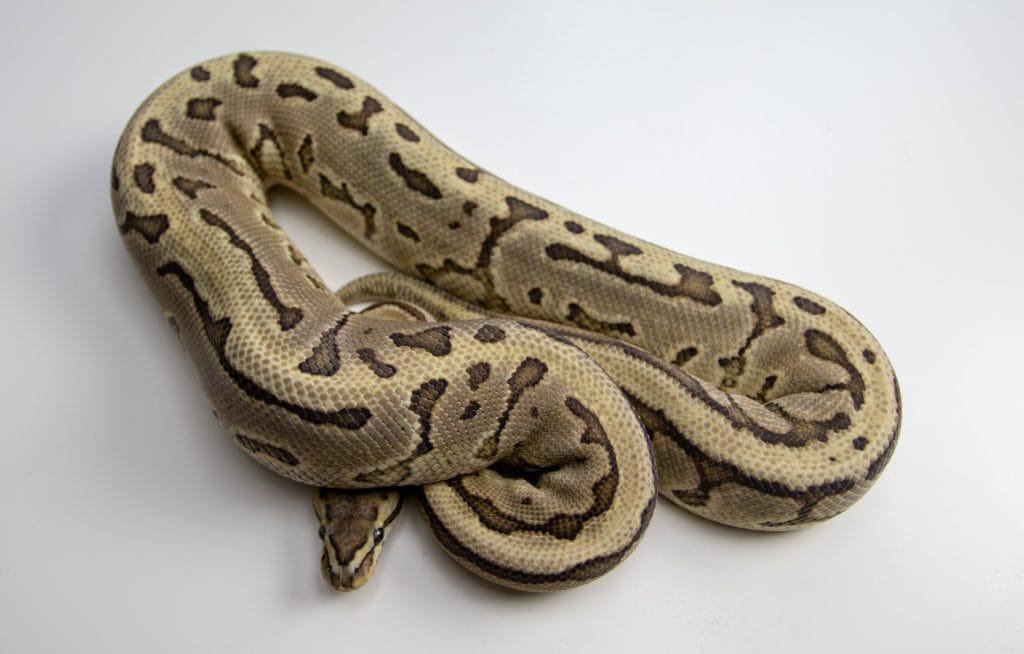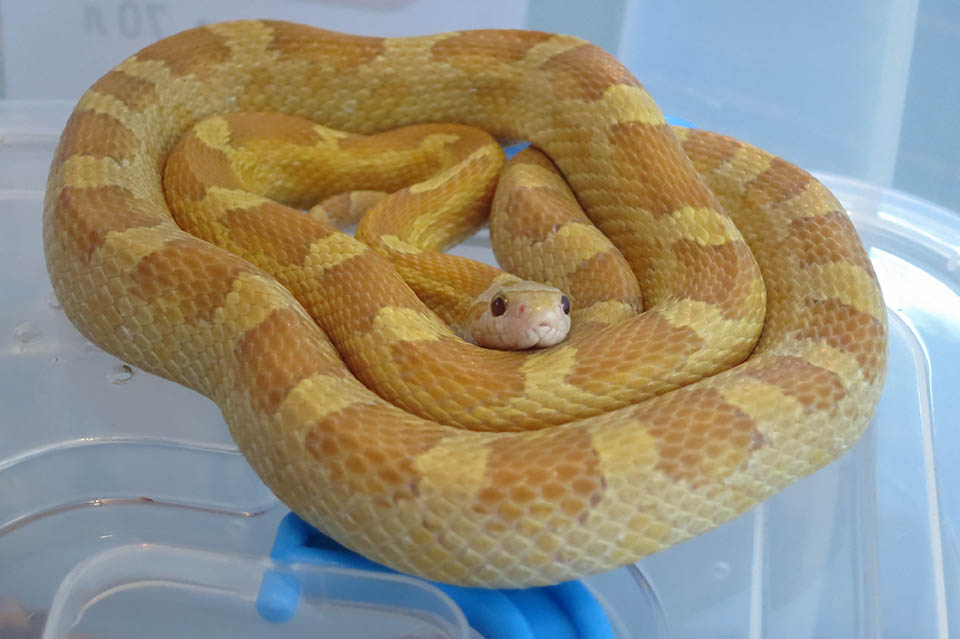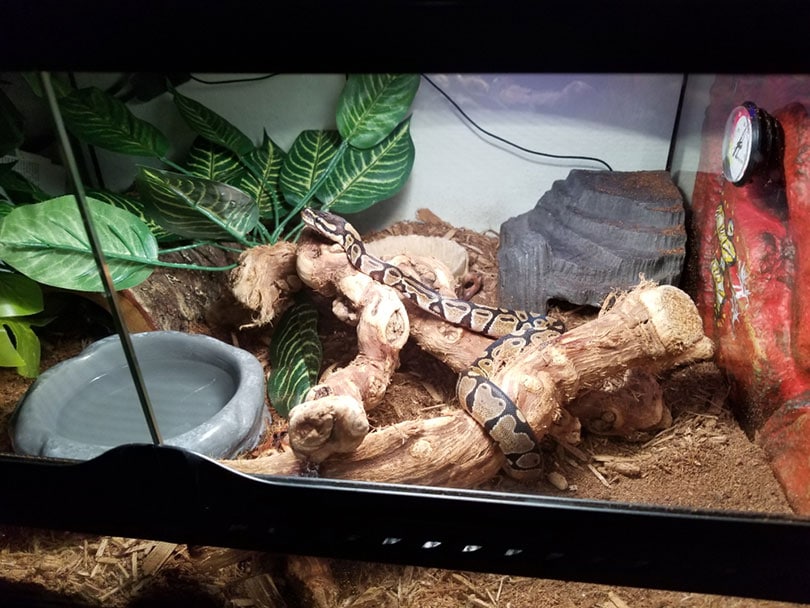
Named after the leopard-like patterns on their skin, Leopard ball pythons are a morph you can get from any ball python. They’re also known as “leopards” in the reptile community.
These snakes are popular because they have an attractive pattern and don’t shed much. Plus, they’re relatively easy to care for!
In this blog post, we’ll talk about what these animals need to live happily and how to take care of them. We’ll also touch on some misconceptions about these gorgeous creatures. So if you’ve been thinking about getting one or know someone who has one, read along!
 Quick Facts about Leopard Ball Pythons
Quick Facts about Leopard Ball Pythons
| Species Name: | Python Regius |
| Common Name: | Ball Python |
| Care Level: | Beginner |
| Lifespan: | 20-30 years |
| Adult Size: | 4 to 5 feet |
| Diet: | Small rodents |
| Minimum Tank Size: | 40 gallons
|
| Temperature & Humidity | Temperature: 80°F – 90°F
Humidity: 50-60% |
Do Leopard Ball Pythons Make Good Pets?
Yes! They’re active and curious, can be handled daily, and are easy to keep. If you’ve never owned snakes before, leopard ball pythons may just be the perfect pet for you!
Leopard ball pythons are usually quite docile. They’re not aggressive and will rarely strike at you without warning. Most of the time, they’ll be quite calm – just sitting around doing nothing in particular!
Another reason why these snakes make good pets is that they don’t require much space. They can live in a small enclosure with just enough room for them to move around comfortably.
You can also handle leopard ball pythons daily, but of course, it depends on your comfort level. If you’re very uncomfortable with holding snakes, it’s okay to let them out independently for a couple of days in-between handling.

Appearance
These snakes are relatively small and will only grow to an adult length of 4-5 feet. They’re also not very heavy! A full-grown leopard ball python can weigh less than 100 grams.
They can have small black spots, a few bolder black lines, and some yellow lines on their skin. Some leopards even have faint stripes! However, their coloring makes them unique because they have patterns that make them look like a leopard.
The coloring is inherited from the parents. After their first shed, these snakes have beautiful patterns that make them unique compared to other ball pythons.
 How to Take Care of Leopard Ball Pythons
How to Take Care of Leopard Ball Pythons
Leopard ball pythons have low maintenance requirements than bigger snakes, but that doesn’t mean you should skimp out on the essentials! Here are a few things you absolutely must know when taking care of a leopard ball python.
Habitat, Tank Conditions & Setup
Tank
The enclosure for a leopard ball python should be at least 20 gallons, with plenty of room to move around.
Leopard ball pythons will spend most of their time climbing. Ensure the enclosure has a place for them to climb and put in some fake vines or branches for them to cling on to!
These snakes aren’t particular about materials used in the tank, but they should be easy to clean and disinfect. Make sure there is no cork bark in your tank (this can cause problems for these non-poisonous snakes.)
Lighting
Ball pythons are nocturnal, but they do need some light to be able to shed properly. It’s ideal if you put in a full-spectrum UVB bulb near your snake’s tank for 8 hours every day.
This is optional, and the snake can also live without any lighting at all. However, if you want to provide the best conditions possible for your pet, putting in a light source is recommended!

Heating (Temperature & Humidity)
When it comes to heating a snake’s enclosure, it’s important to try and recreate the animal’s natural habitat. This species is originally from western Africa and is used to tropical climates. They’re comfortable at 75-85 degrees Fahrenheit.
Since leopard ball pythons are nocturnal animals, you should drop the temperature down to 70 degrees during the day. At night time, it will be ideal if you can keep the temperature around 80-82 degrees Fahrenheit.
Humidity levels should be kept low. Ball pythons usually live in arid regions and don’t need much humidity.
Substrate
The substrate should be a loose, spot-clean-only material. Products like fleece, aspen shavings, or kiln-dried pine work well for this. You’ll want to remove any fecal matter immediately with warm water and soap. Don’t use any harsh chemicals to clean the tank!
Tank Recommendations
| Tank Type: | 40 gallon glass vivarium |
| Lighting: | UVB Lighting |
| Heating: | Heating pad/tape on bottom of enclosure |
| Best Substrate: | Aspen bedding |
 Feeding Your Leopard Ball Python
Feeding Your Leopard Ball Python
When it comes to feeding your pet, don’t overlook it! Leopard ball pythons can grow up to 4 feet long and easily weigh up to 100 grams. They must get enough food every day because that’s how they grow.
They will usually eat between 2-3 small rodents per week, depending on their size and activity level. It’s recommended that you feed them at least once a week, but they can go longer without eating if they’re not active.
If necessary, you can provide supplemental calcium in their diet by dusting the food with powdered calcium every other feeding during the shedding season. This will help your pet shed properly!

Diet Summary
| Rodents | |
| Small Birds/Lizards | |
| Calcium Supplements | Optional |
Keeping Your Leopard Ball Python Healthy
Leopard ball pythons are generally healthy. They’re not prone to many health issues compared to other snakes, so as long as you provide them with good care, they should live a long time! However, there are some things that you can watch out for in your pet’s behavior to help detect any problems early on.
Common Health Issues
Ball pythons are susceptible to respiratory infections, which are the leading cause of death in captive snakes. They can pick up these infections from their food or when they’re cleaning themselves on the floor of their enclosure.
If your pet shows signs of labored breathing, such as slow-motion or rattling noises while inhaling and exhaling, then something is wrong, and it might be a good idea to visit the vet.
Lifespan
Due to their good overall health, ball pythons can live from 20-30 years in captivity. Some can go even longer!

Breeding
You can breed your ball python once it reaches sexual maturity, anywhere between 3-5 years of age. You’ll have to find a mate for your pet from another owner. It’s common for owners to sell their male ball pythons with breeding rights, so you should make sure the buyer knows how to handle the snake properly during the breeding season.
 Are Leopard Ball Pythons Friendly? Our Handling Advice
Are Leopard Ball Pythons Friendly? Our Handling Advice
Handling a leopard ball python for the first time can be an exciting experience. But remember, your pet is a wild animal and can get scared easily. Make sure you know what to do if the snake strikes or climbs on your hand.
The best way to hold a leopard ball python is by supporting its neck securely with one hand and firmly grasping its tail with the other hand. Make sure you don’t squeeze the snake and hold it at a comfortable distance from your body.
If the snake feels threatened, it will try to escape by striking and lashing out with its tongue. You must keep them within sight, so they can rest comfortably without getting away!
Shedding & Brumation: What to Expect
Your leopard ball python will shed its skin every month or two. It’s best to provide them with a secure hiding spot, such as an egg crate with plenty of ventilation holes so that they can feel safe during this time.
When you see your pet shedding its skin, don’t try to remove the skin from its body by pulling it. This could be very stressful and painful for your pet, so make sure you wait until they shed entirely on their own.
How Much Do Leopard Ball Pythons Cost?

Leopard ball pythons are among the most beautiful morphs and the most popular among ball python hobbyists. As a result, it’s easy to find them for sale online or at pet stores!
The current price of a leopard ball python can start from $250-500, depending on its quality and rarity. If you want your pet to be truly special, then the price can go up to $1000 or more, depending on the color and pattern combination.
Care Guide
There are many different types of ball pythons, but the leopard is truly unique among them. You can easily tell that it’s a leopard by looking at its yellow and black body pattern, and you’ll see this design replicated in other animals in nature as well!
This beautiful snake will make a wonderful pet for beginners due to its easy maintenance and relatively calm personality. If you want to learn how to handle a leopard ball python, just make sure they’re comfortable while holding them.
Follow the tips above, and don’t be afraid to ask us if you have questions!
Featured Image Credit: beachbumxotics, Pixabay
 Quick Facts about Leopard Ball Pythons
Quick Facts about Leopard Ball Pythons How to Take Care of Leopard Ball Pythons
How to Take Care of Leopard Ball Pythons Feeding Your Leopard Ball Python
Feeding Your Leopard Ball Python






